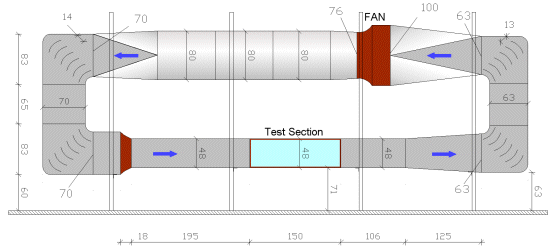The Research and Educational Wind Tunnel (R&E-WT) at the Department of Civil Engineering is a closed-circuit wind tunnel type. The air is circulated through a vertical installed duct system as illustrated below. The main working part is the lower stretch of the wind tunnel. Here, the airflow approaches from the left to the test section. The part upstream of the test section is called the fetch, where installations such as small blocks or thin plates allow for generating a turbulent flow similar to the wind flow in the earth's atmosphere. In basic configuration the flow is smooth, i.e. of low turbulence intensity (< 1%).

Principle sketch and main dimensions of the Research and Educational Wind Tunnel.(all measures in [cm] - basic wind tunnel configuration)
The R&E-WT is primarily used for the study of fundamental fluid mechanical effects around single bodies and for demonstration of particular load effects on civil engineering structures and their reponses. Furthermore, the wind tunnel is used to prepare test setups for experiments in other larger wind tunnel facilities to reduce occupation time and to train students for their project work. The below listed dimension and flow properties refer to the basic configuration of the wind tunnel.
| Property/Dimension |
Value |
| Test section inner cross-section |
47 x 47 cm |
| Test section length |
150 cm |
| Maximum airspeed in basic configuration |
29.5 m/s |
| Minimum turbulence intensity Iu |
< 1 % |
Even though of small dimensions the R&E-WT allows for the simulation of a turbulent flow similar to the turbulent boundary layer flow in the earth's atmosphere, namely the natural wind. The comprehensive setup is ideal for comparative studies between physical and numerical simulation of wind flow. The latter, i.e. the numerical simulation, addresses the field of Computational Wind Engineering (CWE), which is one of the future research areas within the CESDyn group.



a) View on the working area around the wind tunnel with the test section. b) Flow visualisation of vortex shedding from a generic ice covered cable model. c) Test section of the wind tunnel with a setup for flow visualisation.